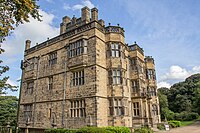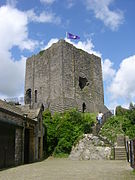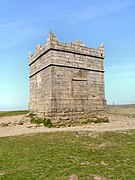Lancashire
The county has an area of 3,079 square kilometres (1,189 sq mi) and a population of 1,490,300. Preston is located near the centre of the county, which is urbanised and includes the towns of Blackburn and Burnley; the seaside resort of Blackpool lies to the west, and Lancaster is in the north. For local government purposes Lancashire comprises a non-metropolitan county, with twelve districts, and two unitary authority areas: Blackburn with Darwen and Blackpool. The county historically included northern Greater Manchester and Merseyside, the Furness and Cartmel peninsulas of Cumbria, and part of northern Cheshire, but excluded the eastern part of the Forest of Bowland.
The west of Lancashire contains flat coastal plains: the West Lancashire coastal plain to the south and the Fylde in the centre. The north-western coast is hilly and contains part of Arnside and Silverdale, a national landscape. The east of the county is upland, with the West Pennine Moors in the south-east and the Forest of Bowland in the north-east; Bowland has also been designated a national landscape. The major rivers of the county are, from north to south, the Lune, the Wyre, and the Ribble, which all flow west into the Irish Sea. The highest point in Lancashire is either Gragareth or Green Hill, both approximately 628 m (2,060 ft) high and located in the far north-east of the county.
Lancashire was founded in the 12th century; in the Domesday Book of 1086 much of what would become the county is treated as part of Yorkshire and Cheshire. Until the Early Modern period the county was a comparatively poor backwater, although in 1351 it became a palatine, with a semi-independent judicial system. This changed during the Industrial Revolution, when the county rapidly industrialised; until 1974 it included both Liverpool, a major port, and Manchester, which with its surrounding towns dominated the manufacture of textiles. The Lancashire coalfield was also exploited, with many collieries opening. By 1971 Lancashire had a population of 5,118,405, which made it the most heavily populated county in the United Kingdom after Greater London.
History
Before the county
During Roman times the area was part of the Brigantes tribal area in the military zone of Roman Britain. The towns of Manchester, Lancaster, Ribchester, Burrow, Elslack and Castleshaw grew around Roman forts. In the centuries after the Roman withdrawal in 410 AD the northern parts of the county probably formed part of the Brythonic kingdom of Rheged, a successor entity to the Brigantes tribe. During the mid-8th century, the area was incorporated into the Anglo-Saxon Kingdom of Northumbria from the north of the River Ribble and the Kingdom of Mercia from the south, which both became parts of England in the 10th century.
In the Domesday Book, land between the Ribble and Mersey were known as "Inter Ripam et Mersam" and included in the returns for Cheshire. Although some historians consider this to mean south Lancashire was then part of Cheshire, it is by no means certain. It is also claimed that the territory to the north formed part of the West Riding of Yorkshire.
Early history

The county was established in 1182, and came to be bordered by Cumberland, Westmorland, Yorkshire, and Cheshire. It was divided into the hundreds of Amounderness, Blackburn, Leyland, Lonsdale, Salford and West Derby. Lonsdale was further partitioned into Lonsdale North, the detached part north of the sands of Morecambe Bay including Furness and Cartmel, and Lonsdale South.
Victorian era to late 20th century
Since the Victorian era, Lancashire has had multiple reforms of local government. In 1889, the administrative county of Lancashire was created, covering the greater part of the county. Multiple county boroughs were outside the county council control: Barrow-in-Furness, Blackburn, Bolton, Bootle, Burnley, Bury, Liverpool, Manchester, Oldham, Preston, Rochdale, Salford, St. Helens, and Wigan. The area served by the Lord-Lieutenant (termed now a ceremonial county) covered the entirety of the administrative county and the county boroughs. It expanded whenever boroughs annexed areas in neighbouring counties such as Wythenshawe in Manchester south of the River Mersey and from Cheshire, and southern Warrington. It did not cover the western part of Todmorden, where the ancient border between Lancashire and Yorkshire passes through the middle of the town.
During the 20th century, the county became increasingly urban with Warrington (1900), Blackpool (1904) and Southport (1905) becoming county boroughs, with many boundary extensions. The borders around the Manchester area were particularly complicated, with narrow protrusions of the administrative county between the county boroughs – Lees Urban District formed a detached part of the administrative county, between Oldham county borough and the West Riding of Yorkshire. Lancaster, the historic county town, became a city in 1937.
The administrative county was also the most populous of its type outside London, with a population of 2,280,359 in 1961. By the census of 1971, the population of Lancashire and its county boroughs had reached 5,129,416, making it the most populous geographic county in the UK.
Post-1974

On 1 April 1974, under the Local Government Act 1972, southern parts of administrative Lancashire were transferred to the two newly established metropolitan counties of Merseyside and Greater Manchester. Widnes and Warrington, which did not form part of either new county but which were cut off from the rest of Lancashire, were transferred to Cheshire. In the north, the new county of Cumbria incorporated the Furness exclave.
The new ceremonial county of Lancashire also gained land in 1974, as the urban districts of Barnoldswick and Earby, Bowland Rural District, and the parishes of Bracewell and Brogden and Salterforth from Skipton Rural District were transferred from the West Riding of Yorkshire.
One parish, Simonswood, was transferred from the borough of Knowsley in Merseyside to the district of West Lancashire in 1994. In 1998 Blackpool and Blackburn with Darwen became unitary authorities, removing them from the non-metropolitan county but not from the ceremonial county.
As the new boundary changes came into effect on 1 April 1974, a government statement in The Times newspaper stated: “They are administrative areas and will not alter the traditional boundaries of counties”.
Geography
Geology, landscape, and ecology

The three main rivers in Lancashire are the Ribble, Wyre and Lune, which all drain west to the Irish Sea. The Wyre rises in Bowland and is entirely within Lancashire, while the Ribble and Lune rise in North Yorkshire and Cumbria respectively. Many of Lancashire's other rivers are tributaries of the Ribble, including the Calder, Darwen, Douglas, and Hodder. The Irwell, which flows through Manchester, has its source in Lancashire.
To the west of the county are the Fylde coastal plain and West Lancashire coastal plain, which lie north and south of the Ribble Estuary respectively. Apart from the coastal resorts these areas are largely rural and devoted to vegetable crops. Further north is Morecambe Bay. In the northwest corner of the county, straddling the border with Cumbria, is the Arnside and Silverdale National Landscape, characterised by its limestone pavements and home to the Leighton Moss nature reserve.
In the east of the county are upland areas leading to the Pennines. North of the Ribble are Beacon Fell Country Park and the Forest of Bowland, another National Landscape. Much of the lowland in this area is devoted to dairy farming and cheesemaking, whereas the higher ground is more suitable for sheep, and the highest ground is uncultivated moorland. The valleys of the River Ribble and its tributary the Calder form a large gap to the west of the Pennines, overlooked by Pendle Hill. South of the Ribble are the West Pennine Moors and the Forest of Rossendale, where former cotton mill towns are in deep valleys. The Lancashire Coalfield, largely in modern-day Greater Manchester, extended into Merseyside and to Ormskirk, Chorley, Burnley and Colne in Lancashire.
The highest point of the ceremonial county is Gragareth, near Whernside, which reaches a height of 627 m (2,057 ft). Green Hill near Gragareth has also been cited as the "county" top. The highest point in the historic county is Coniston Old Man in the Lake District, at 803 m (2,634 ft).
Human geography

The north of the ceremonial county is less densely populated than the south, especially inland. The Fylde coast forms a continuous built-up area from Lytham St Annes to Fleetwood, including Blackpool, and further north is the Lancaster/Morecambe built-up area. The rest of the region is characterised by small towns and villages in the flat farmland surrounding the lower reaches of the Ribble, Wyre, and Lune and the sparsely populated uplands of the Forest of Bowland.
The centre and south-east of Lancashire is relatively urbanised, especially around the major settlements of Preston, Blackburn, and Burnley and near the border with Greater Manchester. The Central Lancashire urban area includes the city of Preston and the towns of Penwortham, Leyland and Chorley. A short distance east, Blackburn and Darwen are the first of several adjacent areas urban areas which stretch east toward West Yorkshire and south into the valleys leading to Greater Manchester, the others being Accrington and Rossendale and Burnley. West Lancashire in the south-west is rural with the exception of Skelmersdale, which forms part of Wigan urban area.
The North West Green Belt covers a large part of the south and centre of the county, including all of the non-urban areas in the boroughs of West Lancashire and South Ribble and the majority of Chorley. Elsewhere it is less extensive but covers the areas between the major settlements to prevent their convergence both with each other and with the nearby Merseyside and Greater Manchester conurbations. There is a further area of green belt in the north of the county, between Lancaster, Morecambe, and Carnforth.
Some settlements within the historic county boundaries are in the ceremonial counties of West Yorkshire, Cheshire, Merseyside, Greater Manchester and Cumbria:
| To ceremonial | From historic Lancashire |
|---|---|
| Greater Manchester |
|
| Merseyside | |
| Cumbria | |
| Cheshire | |
| West Yorkshire | Todmorden (part) |
| From historic | To ceremonial Lancashire |
| West Riding of Yorkshire |
Boundary changes before 1974 include:
- Todmorden, split between Lancashire and Yorkshire then entirely to West Riding of Yorkshire in 1889
- Mossley, split between Lancashire, Yorkshire and Cheshire then entirely to Lancashire in 1889
- Stalybridge, entirely to Cheshire in 1889
- Areas such as Wythenshawe and Latchford, former county boroughs of Manchester and Warrington both extended south of the Mersey into historic Cheshire
- areas such as Reddish and the Heatons (Heaton Chapel, Heaton Mersey, Heaton Moor and Heaton Norris), former county borough of Stockport extended north into historic Lancashire.
Governance
Local government

The ceremonial county of Lancashire is divided into fourteen local government districts. Twelve are part of the two-tier non-metropolitan county of Lancashire, which is administered by Lancashire County Council and twelve district councils. Lancashire County Council is based in County Hall in Preston, and has 84 councillors. The council has been controlled by the Conservative Party since the 2017 Lancashire County Council elections; the 2021 elections they won 48 seats, the Labour Party won 32, and the Liberal Democrats and the Green Party won two each. The twelve districts of the non-metropolitan county are Burnley, Chorley, Fylde, Hyndburn, Lancaster, Pendle, Preston, Ribble Valley, Rossendale, South Ribble, West Lancashire, and Wyre.
Blackpool and Blackburn with Darwen are unitary authorities, meaning their councils combine the functions of a district and county council. They were formed in 1996, before which each district was part of the non-metropolitan county of Lancashire. Both authorities currently have a majority Labour administration.

The ceremonial county itself only has a minor administrative functions, being the area to which the Lord Lieutenant of Lancashire is appointed; the shrieval county has the same boundaries and is the area to which the High Sheriff of Lancashire is appointed. As of 2023 these positions are held by Amanda Parker and David Taylor respectively.
Parliamentary constituencies
The ceremonial county is divided into sixteen constituencies for the purpose of parliamentary representation.
| Conservative | Labour | Liberal Democrats | Green | Brexit Party | Others | Turnout |
|---|---|---|---|---|---|---|
| 331,000 −7,000 |
270,000 −92,000 |
37,000 +9,000 |
19,000 +10,000 |
16,000 +16,000 |
41,000 +39,000 |
716,000 −34,000 |
| Conservative | Labour | Liberal Democrats | Green | Brexit Party | Others |
|---|---|---|---|---|---|
| 11 +3 |
4 −4 |
0 — |
0 — |
0 — |
1 (Speaker) +1 |
Duchy of Lancaster
The Duchy of Lancaster, the private estate of the sovereign, exercises the right of the Crown in the County Palatine of Lancaster. The most prominent effect of this is that the Duchy administers bona vacantia within the County Palatine, receiving the property of persons who die intestate and where the legal ownership cannot be ascertained. The county palatine boundaries remain the same as the historic boundaries, ignoring subsequent local government reforms.
Economy
Lancashire in the 19th century was a major centre of economic activity, and hence one of wealth. Activities included coal mining, textile production, particularly that which used cotton, and fishing. Preston Docks, an industrial port is now disused. Lancashire was historically the location of the port of Liverpool while Barrow-in-Furness is famous for shipbuilding.
As of 2013, the largest private sector industry is the defence industry with BAE Systems Military Air Solutions division based in Warton on the Fylde coast. The division operates a manufacturing site in Samlesbury. Other defence firms include BAE Systems Global Combat Systems in Chorley, Ultra Electronics in Fulwood and Rolls-Royce plc in Barnoldswick.
The nuclear power industry has a plant at Springfields, Salwick operated by Westinghouse and Heysham nuclear power station is operated by British Energy. Other major manufacturing firms include Leyland Trucks, a subsidiary of Paccar building the DAF truck range.
Other companies with a major presence in Lancashire include:
- Airline Network, an internet travel company with headquarters in Preston.
- Baxi, a heating equipment manufacturer has a large manufacturing site in Bamber Bridge.
- Crown Paints, a major paint manufacturer based in Darwen.
- Dr. Oetker, an international food processing company, has a factory in Leyland that produces frozen pizza mostly under the Chicago Town and Ristorante brands.
- Enterprise plc, one of the UK's leading support services based in Leyland.
- Hanson plc, a building supplies company operates the Accrington brick works.
- Hollands Pies, a major manufacturer of baked goods based in Baxenden near Accrington.
- National Savings and Investments, the state-owned savings bank, which offers Premium Bonds and other savings products, has an office in Blackpool.
- Thwaites Brewery, a regional brewery founded in 1807 by Juno Thwaites in Blackburn.
- Xchanging, a company providing business process outsourcing services, with operations in Fulwood.
- AB InBev, a multinational beverage company, brews Budweiser, Stella Artois, Brahma, Bass and Boddingtons in Samlesbury.
- Fisherman's Friend, a confection company, famous for making strong mints and lozenges, based in Fleetwood.
- The Foulnaze cockle fishery is in Lytham. It has only opened the coastal cockle beds three times in twenty years; August 2013 was the last of these openings.
Enterprise zone
The creation of Lancashire Enterprise Zone was announced in 2011. It was launched in April 2012, based at the airfields owned by BAE Systems in Warton and Samlesbury. Warton Aerodrome covers 72 hectares (180 acres) and Samlesbury Aerodrome is 74 hectares. Development is coordinated by Lancashire Enterprise Partnership, Lancashire County Council and BAE Systems. The first businesses to move into the zone did so in March 2015, at Warton.
In March 2015 the government announced a new enterprise zone would be created at Blackpool Airport, using some airport and adjoining land. Operations at the airport will not be affected.
Economic output

This is a chart of trend of regional gross value added of the non-metropolitan county of Lancashire at basic prices published by the Office for National Statistics with figures in millions of British pounds sterling.
| Year | Regional Gross Value Added | Agriculture | Industry | Services |
|---|---|---|---|---|
| 1995 | 13,789 | 344 | 5,461 | 7,984 |
| 2000 | 16,584 | 259 | 6,097 | 10,229 |
| 2003 | 19,206 | 294 | 6,352 | 12,560 |
Education
Lancashire has a mostly comprehensive system with four state grammar schools. Not including sixth form colleges, there are 77 state schools (not including Burnley's new schools) and 24 independent schools. The Clitheroe area has secondary modern schools. Sixth form provision is limited at most schools in most districts, with only Fylde and Lancaster districts having mostly sixth forms at schools. The rest depend on FE colleges and sixth form colleges, where they exist. South Ribble has the largest school population and Fylde the smallest (only three schools). Burnley's schools have had a new broom and have essentially been knocked down and started again in 2006. There are many Church of England and Catholic faith schools in Lancashire.
Lancashire is home to four universities: Lancaster University, the University of Central Lancashire, Edge Hill University and the Lancaster campus of the University of Cumbria. Seven colleges offer higher education courses.
Transport
Roadways

The Lancashire economy relies strongly on the M6 motorway which runs from north to south, past Lancaster and Preston. The M55 connects Preston to Blackpool and is 11.5 miles (18.3 km) long. The M65 motorway from Colne, connects Burnley, Accrington, Blackburn to Preston. The M61 from Preston via Chorley and the M66 starting 500 metres (0.3 mi) inside the county boundary near Edenfield, provide links between Lancashire and Manchester, and the trans-Pennine M62. The M58 crosses the southernmost part of the county from the M6 near Wigan to Liverpool via Skelmersdale.
Other major roads include the east–west A59 between Liverpool in Merseyside and Skipton in North Yorkshire via Ormskirk, Preston and Clitheroe, and the connecting A565 to Southport; the A56 from Ramsbottom to Padiham via Haslingden and from Colne to Skipton; the A585 from Kirkham to Fleetwood; the A666 from the A59 north of Blackburn to Bolton via Darwen; and the A683 from Heysham to Kirkby Lonsdale via Lancaster.
Several bus companies run bus services in the Lancashire area serving the main towns and villages in the county with some services running to neighbouring areas, Cumbria, Greater Manchester, Merseyside and West Yorkshire. Some of these include:
- Stagecoach Merseyside & South Lancashire
- Stagecoach Cumbria & North Lancashire
- Stagecoach Manchester
- Transdev Blazefield
- Preston Bus











